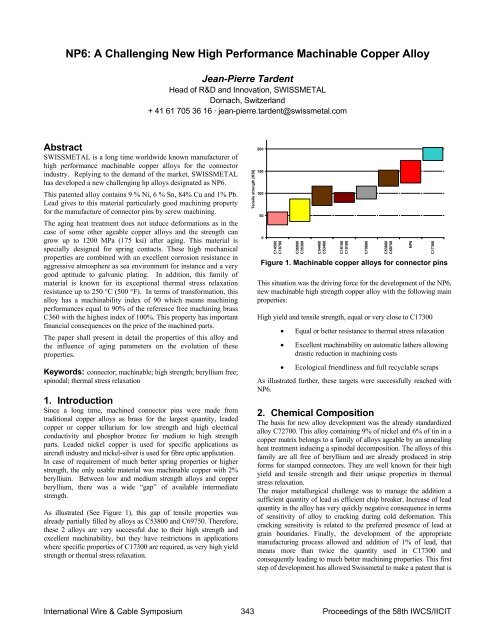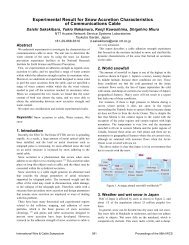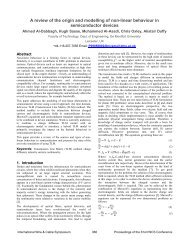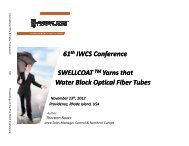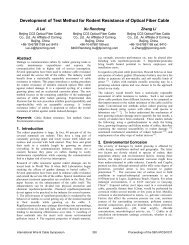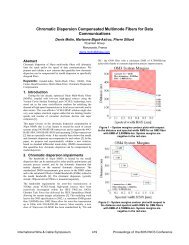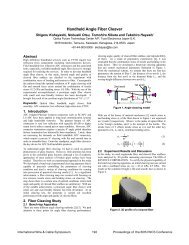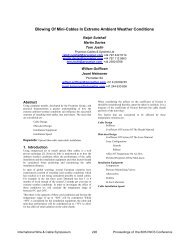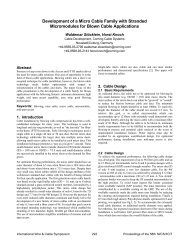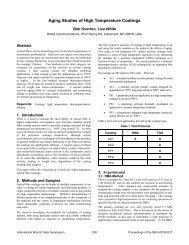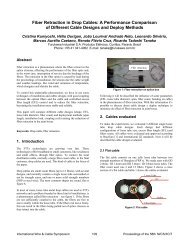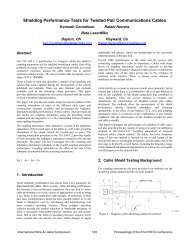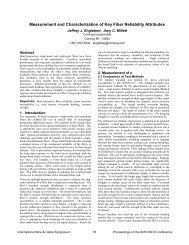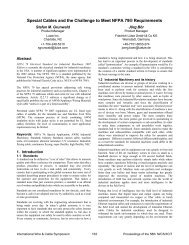NP6: A Challenging New High Performance Machinable Copper Alloy
NP6: A Challenging New High Performance Machinable Copper Alloy
NP6: A Challenging New High Performance Machinable Copper Alloy
You also want an ePaper? Increase the reach of your titles
YUMPU automatically turns print PDFs into web optimized ePapers that Google loves.
currently in acceptation phase in various countries through theworld.A second development step was recently achieved with thecooperation of the Professor Andreas Mortensen of the SwissFederal Technical University in Lausanne. This steps consists in theaddition of other elements as phosphorous for instance with a verypositive influence on grain boundaries embrittlement problems athigh temperatures. This second step has lead to the deposit of asecond patent.3. Mechanical Properties3.1 Tensile PropertiesAs describe in table 1 (see Table 1), yield and tensile strength of<strong>NP6</strong> in the full hard temper state (TH04) are situated in the lowerrange of C17300 and are considered as high enough to comply withspring properties requirements of the majority of spring contactsactually machined from C17300.at this temperature. The danger of over aging appears at highertemperatures, even for short times at temperatures.3.3 Effect of cold deformation before and afteraging<strong>NP6</strong> is a material destined to be used at high levels of yield andtensile strength and that is the reason why the material is first colddrawn before thermal aging. The cold deformability of <strong>NP6</strong> issignificantly better than in case of C17300. The machinable copperberyllium can absorb a typical maximum cold drawing of 50 to 55% before and <strong>NP6</strong> can be cold deformed up to 80% in the samedrawing conditions. Therefore, the aging effect is more efficient inC17300 than in the case of the spinodal decomposition of <strong>NP6</strong> andconsequently, there is no necessity to deform C17300 as much as<strong>NP6</strong> to reach the highest levels of yield and tensile strength.The following Figure 3 illustrates the effect of cold drawing onevolution of mechanical properties of <strong>NP6</strong> for a unique set of agingparameters that means 660 °F – 1 hour.Table 1. Comparison of typical tensile properties intemper TH04E (KSI) Rp0.2 (KSI) Rm (KSI) A 4in . (%)C17300 19’000 160 - 200 185 - 225 2 - 9200190180Aged mechanical strengthMechanical strengthAged yield strengthYield strengthAged elongationElongationAged hardnessHardnessA (%)8<strong>NP6</strong> 18’000 145 - 160 150 - 175 1- 23.2 Effect of aging parametersThe age hardening mechanism is different in C17300 and in <strong>NP6</strong>.<strong>Copper</strong> Beryllium is hardened by a classical precipitationmechanism whereas <strong>NP6</strong> is a typical alloy hardened by spinodaldecomposition. Therefore, both categories of alloys present similarbehaviors related to aging parameters, especially in case of overaging as illustrated in Figure 2 for <strong>NP6</strong>.Mechanical strength (KSI)180170160150140130120110100900 2 4 6 8 10 12 14Time (h)608°F635°F662°F707°F752°F797°FFigure 2. Effect of aging parameters on tensile strengthafter initial cold drawing of 60%The maximization of tensile strength is reached by a heattreatment at relatively low temperature (608 °F), but during a timeof 8 to 10 hours. Therefore, this time is practically not usable inan industrial context and that is the reason why the recommendedaging parameters are 650 °F to 660 °F during 2 to 4 hours. Evenin case of overtime of annealing, there is no danger of over agingYield strength & Mechanical Strength (KSI)170160150140130120110100908070040 45 50 55 60 65 70 75 80 85Strain hardening (%)642HV 0.5Figure 3: effect of cold drawing on mechanical propertiesof <strong>NP6</strong> before and after aging3.4 Modulus of elasticityThis aspect is particularly important in case of female contacts thathave to ensure minimum or maximum or constant retention forceswhen plugged with male connector pins and in the context of directreplacement of C17300 parts through <strong>NP6</strong> pieces.The following Figure 4 displays the elastic behavior of variousalternatives to C17300 with C17300.400350300250200International Wire & Cable Symposium 344 Proceedings of the 58th IWCS/IICIT
Stress [KSI]2001801601401201008060402000 0.1 0.2 0.3 0.4 0.5 0.6 0.7 0.8 0.9 1Elongation [%]C17300C69750Elastic field=<strong>NP6</strong>C53800Figure 4. Comparisons of elastic behavior of C17300 withalternativesIt appears clearly that C69750 or C53800 are presenting lowerretention forces compared with C17300 for same deflexions in theelastic field. This fact was demonstrated practically and resulted inre-design of parts initially made from C17300 and moved to one ofthese 2 alloys. This is not the case with <strong>NP6</strong> that has a modulus ofelasticity so close to C17300 that a piece actually manufactured inberyllium copper can be immediately made from <strong>NP6</strong> without redesignnecessity.3.5 Fatigue strength before and after agingIn many applications, including high performance connectors, highyield and tensile strength are not always sufficient criterions for thechoice of a material. An important property is the fatigue strengthensuring a safe use of the material over a long time and a largenumber of variations of mechanical solicitations.considered as excellent in the world of copper alloys. This verygood result was unexpected as the remaining elongation is lowerthan in the case of C17300 for the same temper. This result is a signof a good toughness of this family of “spinodal” copper alloys.4. Thermal stress relaxationThe use of classical machinable copper alloys as brass or phosphorbronze for female connectors in an environment exceeding 200 °Fover a long period of time is generally not possible due to loss ofretention properties induced by phenomenon of thermal stressrelaxation.In such cases, connector designers use either leaded nickel copper asC19150 or C19160 for medium level of solicitations or C17300 forhigher performances. The family of CuNiSn alloys with spinodaldecomposition is known for their excellent properties in thermalstress relaxation.As demonstrated by laboratory tests and reported in figure 6, thisexcellent behaviour is maintained with <strong>NP6</strong>.Residual stress [%]1009080706050403020100C17300150 200 250 300 350 400 450 500<strong>NP6</strong>Stress amplitude [KSI]Fatigue <strong>NP6</strong> with 60% cold deformationbefore aging heat treatment5550454035302520R = 0.115RT10f = 28 Hz5010'000 100'000 1'000'000 10'000'000 100'000'000Temperature [°F]Figure 6. Thermal stress relaxation of <strong>NP6</strong> and C17300after 1000 hours at temperature and initial stress equal to75% of yield strengthUp to 350 °F, both C17300 and <strong>NP6</strong> have an identical behaviour.Over 350 °F, the remaining stress of C17300 starts to dropdramatically. That is not the case of <strong>NP6</strong> that is keeping usableremaining stress up to 500 °F, allowing the use of this material inmuch severer temperature and load conditions than in the case ofC17300.55Cycles NFatigue <strong>NP6</strong> with 60% cold deformationafter aging heat treatment5. Physical PropertiesAs illustrated in Table 2, physical properties of C17300 and <strong>NP6</strong>are very similar, excepting for electrical and thermal conductivity.Stress amplitude [KSI]5045403530252015105R = 0.1RTf = 28 HzTable 2. Physical properties of C17300 and <strong>NP6</strong>C17300<strong>NP6</strong>Density (68°F) (lb/in3) 0.302 0.324Electrical Cond (%IACS) 25 13010'000 100'000 1'000'000 10'000'000 100'000'000Cycles NFigure 5. Elastic fatigue behavior of <strong>NP6</strong> before and afteraging heat treatmentFigure 5 presents the elastic fatigue behavior of <strong>NP6</strong> before andafter aging. The fatigue strength of 35 KSI after aging can beThermal Cond. (Btu/h.ft. °F) 60 18Thermal Expans (μin/in.°F) 9.7 8.9Melting interval(solidus) (°F) 1600 1700Modulus of elasticity (KSI) 19,000 18,000International Wire & Cable Symposium 345 Proceedings of the 58th IWCS/IICIT


